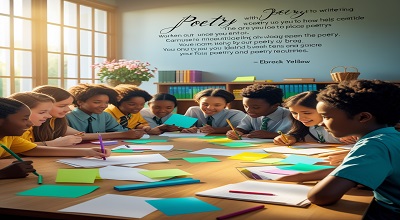Engage Students in Poetry
Engage Students in Poetry: Poetry can be a challenging subject for students, often perceived as abstract or difficult to interpret. However, with the right approach, educators can make poetry engaging and accessible. One effective method is incorporating a simple visual routine that helps students connect with poems on a deeper level.
In this blog post, we will explore a step-by-step visual routine designed to enhance students’ engagement with poetry. This method leverages imagery, color coding, and structured analysis to break down complex poems into digestible parts.
Why Use a Visual Routine for Poetry?
Many students struggle with poetry because it requires abstract thinking and emotional interpretation. A visual routine helps by:
- Simplifying complex ideas through imagery and diagrams.
- Encouraging active participation with hands-on activities.
- Improving retention by linking words to visual cues.
- Making poetry accessible to visual and kinesthetic learners.
The Step-by-Step Visual Routine for Poetry Engagement
1. Pre-Reading: Visual Predictions
Before reading the poem, show students an image or a set of images related to its theme. Ask:
- What emotions do these images evoke?
- What might the poem be about?
This primes students’ minds for deeper engagement.
2. First Read: Listening & Initial Reactions
Play an audio version of the poem (or read it aloud). Students should:
- Sketch quick doodles of words or phrases that stand out.
- Highlight lines that evoke strong feelings.
3. Second Read: Color-Coded Annotation
Assign different colors to:
- Imagery (Blue) – Vivid descriptions.
- Emotions (Red) – Feelings expressed.
- Structure (Green) – Rhyme, rhythm, stanzas.
- Theme (Yellow) – Central message.
This helps students dissect the poem systematically.
4. Visual Mapping: Creating a Poem Mind Map
Students draw a central bubble with the poem’s title and branch out with:
- Key themes
- Symbolism
- Personal connections
- Questions they have
5. Creative Response: Drawing or Collage
Students create a visual representation of the poem using:
- Drawings
- Magazine cutouts
- Digital art
This reinforces comprehension through creativity.
6. Group Discussion: Gallery Walk
Display students’ visual responses and discuss:
- How did different interpretations emerge?
- What new insights did the visuals provide?
Benefits of This Visual Routine
Makes Poetry Fun – Creative activities increase engagement.
Boosts Confidence – Students feel less intimidated by poetry.
Encourages Multiple Perspectives – Visuals reveal diverse interpretations.
Supports Different Learning Styles – Appeals to visual, auditory, and kinesthetic learners.
Conclusion
Using a visual routine transforms poetry from a daunting subject into an interactive and enjoyable experience. By incorporating predictions, color-coding, mind maps, and creative responses, teachers can help students engage with poems in a meaningful way.
